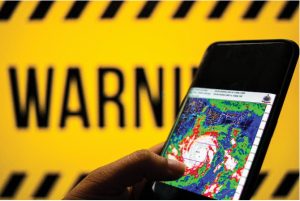— By Steve Peldiak —
The importance of having a disaster plan in place — prior to the emergency at hand.
Did you know, there is a new bill being introduced to streamline disaster recovery assistance? It is named The Natural Disaster Recovery Program Act of 2021. States would be awarded half of the total grant funds immediately after Congress appropriates them, allowing recovery to start faster.

Steve Peldiak, Watterson
Retailers, restaurateurs and commercial property owners need not wait for government intervention. Organizations that made emergency response planning a priority fared much better during events than those that did not. Here are six steps organizations and facility professionals can take to mitigate their losses and protect their interests through disaster response and recovery planning.
Risk to Personnel / Property / Locations / Data
Conduct a personnel risk. An organization’s true essence belongs with the valued personnel, and perils can endanger the health and well-being of a company’s employees. Ensure all-around resources and proper communication for them are the top priorities. Many companies provide all employees with contact numbers they can call should disaster strike. In this way, organizations can track the well-being of their staff members and communicate continuity plans. Next, conduct a property risk assessment that covers all internal and external risks, including environmental, technical, topographical and residing property risks (i.e., the risks surrounding buildings bring to a property). This may include entry points for water, drainage paths and maintenance of sump pumps. Vulnerabilities in power outages that could impact security systems and water/humidity/temperature sensors connected to electricity dependent wi-fi and not operating on an independent battery-operated cellular connection for alerts and alarms.
Emergency Response Procedures and Checklists
Create procedures and checklists based on the risk assessment for various catastrophes such as flooding, fire, wind damage or power failure, include an emergency checklist for each risk. This should also include emergency contact numbers that can be accessed any time, day or night. Remember to include a checklist for precise data transfers to remote servers or cloud-based backups for easy retrieval and sourcing.
Create Key Partnerships
Partner with an experienced emergency restoration company and consider signing on to a service agreement for emergency and disaster situations that provides priority response 24/7/365. The emergency restoration company should have national response capabilities and be able to provide equipment and manpower on a large scale. When a large catastrophe occurs, management should be assured that even though the restoration partner may be inundated with calls, it will have the capacity and resources to respond. The restoration company must also have all the required provincial and federal certifications to enter potentially dangerous situations in a safe manner on the property owner or manager’s behalf.
Create an Overall Emergency Response Plan
All emergency support numbers should be included. They need to be accessible 24/7/365, regardless of location. The plan should also include telephone numbers for  emergency responders, emergency restoration partner, tenant emergency contacts, and city and municipality/provincial emergency numbers. Once perils are identified, establish solutions to issues that are geographical in nature. Important data should be stored across multiple geographic locations. It is prudent that companies maintain data warehouses on a bi-coastal basis to prevent any single occurrence from causing a disruption. Access to locations that can be brought online within hours of a disaster, allowing business to continue, is a must. Technology, data and media are also key factors, and an organization needs professionals trained in these fields.
emergency responders, emergency restoration partner, tenant emergency contacts, and city and municipality/provincial emergency numbers. Once perils are identified, establish solutions to issues that are geographical in nature. Important data should be stored across multiple geographic locations. It is prudent that companies maintain data warehouses on a bi-coastal basis to prevent any single occurrence from causing a disruption. Access to locations that can be brought online within hours of a disaster, allowing business to continue, is a must. Technology, data and media are also key factors, and an organization needs professionals trained in these fields.
Test the Plan
Perform mock disaster recovery exercises or even a desktop scenario exercise and, if possible, partner with a city or municipality’s exercise. Include external emergency response partners such as management’s emergency restoration partner, security company, IT company, cleaning company and any other potential support contractors. Review the plan annually and revise it based on exercise results. Every company should consider purchasing business interruption insurance as part of their recovery plan. Business interruption coverage responds when a covered loss affects the organization’s ability to operate normally. It generally covers the additional costs a company spends to become operational quickly. It may also cover lost revenue caused by the incident. Business interruption coverage only covers certain types of losses, however, with terrorism, war and pandemics typically excluded by the policy.
Invest in Educated Professionals
The field of disaster and resilience management has expanded to create trained professionals who are able to set policy and design solutions. They are also trained to work across departments, communities, government and other emergency resilience practitioners from around the nation to learn and apply best practices.
By making emergency preparation a priority, property owners and managers can severely mitigate damage and loss caused by unexpected disasters and maximize the chances of long term viability.
— Steve Peldiak is president of Watterson, a national provider of facilities maintenance, emergency response and environmental services supporting over 60,000 commercial properties.

